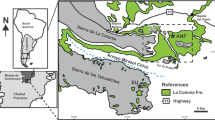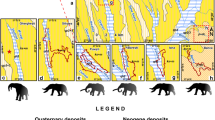Abstract
The first jaw remain of the Late Cretaceous eutherian Labes is a mandibular fragment from the Late Cretaceous (Maastrichtian) locality Massecaps in Departement Herault in southwestern France. The mandible holds three double-rooted molars (m1–3) with broken trigonids and preserved talonids of which m1 apparently was the largest. The entoconid is slightly approximated to the hypoconulid (69–74 % of the distance between the hypoconulid and hypoconid). The talonid basin has a rectangular shape, and the molar roots are not fused. An upper molar (M1) from the same locality bears three roots; it is characterized by a strong ectoflexus and a well-developed parastylar lobe. The largest cusp is the conical pyramidal paracone, followed by the tetrahedral shaped, very low protocone, and the small, distally placed metacone. Previously, Labes was only known by a few isolated lower molars from the late Campanian of Champ-Garimond (France) and the Maastrichtian of El Molino near Quintanilla del Coco (northwestern Spain).
Kurzfassung
Beim ersten Fund eines Kieferrestes des oberkretazischen Eutheriers Labes handelt es sich um ein Mandibel-Fragment aus dem Maastrichtium von Massecaps im Department Herault in Südwestfrankreich. In der Mandibel sind drei zweiwurzelige Molaren (m1–3) mit intakten Taloniden überliefert, während die Trigonide fehlen. Das Entoconid ist dem Hypoconulid leicht angenähert (69–74 % der Entfernung zwischen Hypoconulid and Hypoconid). Das Talonidbecken ist längs-rechteckig und m1 war offenbar der größte Molar im Unterkiefer. Die Molarenwurzeln sind nicht verschmolzen. Ein oberer Molar (M1) mit drei Wurzeln von derselben Lokalität zeigt einen ausgeprägten Ectoflexus und einen prominenten Parastylar-Lobus. Größter Höcker ist der konisch-pyramidenförmige Paraconus, gefolgt vom tetraederförmigen, niedrigen Protoconus und dem kleinen, nach distal gerückten Metaconus. Bisher war Labes nur durch einige wenige isolierte untere Molaren aus dem oberen Campanium von Champ-Garimond (Frankreich) und von El Molino bei Quintanilla del Coco (Nordwest-Spanien) bekannt.





Similar content being viewed by others
Abbreviations
- DP :
-
Deciduous upper premolar
- dp :
-
Deciduous lower premolar
- L :
-
Length
- M :
-
Upper molar
- m :
-
Lower molar
- P :
-
Upper premolar
- p :
-
Lower premolar
- TL :
-
Talonid length
- TW :
-
Talonid width
- w :
-
Width
References
Antunes, M.T., D. Sigogneau-Russell, and D.E. Russell. 1986. Sur quelques dents de mammifères du Crétacé supérieur de Taveiro, Portugal (Note préliminaire). Comptes rendus de l′Académie des Sciences, Paris, II 330: 1247–1250.
Archibald, J.D., and A.O. Averianov. 2012. Phylogenetic analysis, taxonomic revision, and dental ontogeny of the Cretaceous Zhelestidae (Mammalia, Eutheria). Zoological Journal of the Linnean Society 164: 361–426.
Archibald, J.D., Y. Zhang, T. Harper, and R.L. Cifelli. 2011. Protungulatum, confirmed Cretaceous occurrence of an otherwise Paleocene eutherian (Placental?). Journal of Mammalian Evolution 18: 153–161.
Astibia, H., E. Buffetaut, A.D. Buscalioni, H. Cappetta, C. Corral, R. Estes, F. Garcia-Garmilla, J.J. Jaeger, E. Jimenez-Fuentes, J. Le Loeuff, J.M. Mazin, X. Orue-Etxebarria, J. Pereda-Suberbiola, J.E. Powell, J.-C. Rage, J. Rodriguez-Lazaro, J.L. Sanz, and H. Tong. 1991. The fossil vertebrates from Laño (Basque Country, Spain); new evidence on the composition and affinities of the Late Cretaceous continental faunas of Europe. Terra Nova 2: 460–466.
Averianov, A.O., and J.D. Archibald. 2005. Mammals from the mid-Cretaceous Khodzhakul Formation, Kyzulkum Desert, Uzbekistan. Cretaceous Research 26: 593–608.
Buffetaut, E. 1998. First evidence of enantiornithine birds from the Upper Cretaceous of Europe: postcranial bones from Cruzy (Hérault, France). Oryctos 1: 127–130.
Buffetaut, E. 2005. Late Cretaceous vertebrates from the Saint-Chinian area (southern France): a review of previous research and an update on recent finds. Acta Palaeontologica Romaniae 5: 39–48.
Buffetaut, E., J. Le Loeuff, L. Cavin, S. Duffaud, E. Gheerbrant, Y. Laurent, M. Martin, J.-C. Rage, H. Tong, and D. Vasse. 1997. Late Cretaceous non-marine vertebrates from southern France: a review of recent finds. Géobios 20: 101–108.
Buffetaut, E., J. Le Loeuff, H. Tong, S. Duffaud, L. Cavin, G. Garcia, D. Ward, and Association culturelle, archéologique et paleóntologique de Cruzy. 1999. Un nouveau gisement de vertébrés du Crétacé supérieur à Cruzy (Hérault, Sud de la France). Comptes rendus de l′Académie des Sciences, Paris, II 328: 203–208.
Cavin, L., P.L. Forey, E. Buffetaut, and H. Tong. 2005. Latest European coelacanth shows Gondwanan affinities. Biology Letters 1: 176–177.
Cifelli, R.L. 1994. Therian mammals of the Terlingua local fauna (Judithian), Aguja Formation, Big Bend of the Rio Grande, Texas. Contributions to Geology, University of Wyoming 30: 117–136.
Codrea, V., T. Smith, P. Dica, A. Folie, G. Garcia, P. Godefroit, and J. Van Itterbeeck. 2002. Dinosaur egg nests, mammals and other vertebrates from a new Maastrichtian site of the Haţeg Basin (Romania). Comptes Rendus Palevol 1: 173–180.
Csiki, Z., and D. Grigorescu. 2000. Teeth of multituberculate mammals from the Late Cretaceous of Romania. Acta Palaeontologica Polonica 45: 85–90.
Csiki, Z., and D. Grigorescu. 2002. Palaeobiogeoraphical implications of the fossil mammals from the Maastrichtian of the Haţeg Basin. Acta Palaeontologica Romaniae 3: 87–95.
Csiki, Z., D. Grigorescu, and M. Rücklin. 2005. A new multituberculate specimen from the Maastrichtian of Pui, Romania and reassessment of affinities of Barbatodon. Acta Palaeontologica Romaniae 5: 73–86.
Fox, R.C. 1977. Notes on the dentition and relationships of the Late Cretaceous insectivore Gypsonictops Simpson. Canadian Journal of Earth Sciences 14: 1823–1831.
Fox, R.C. 1979. Mammals from the Upper Cretaceous Oldman formation, Alberta. III. Eutheria. Canadian Journal of Earth Sciences 16: 114–125.
Gheerbrant, E., and H. Astibia. 1994. Un nouveau mammifère du Maastrichtien de Laño (Pays basque espagnol). Comptes rendus de l’Académie des Sciences, Paris, II 318: 1125–1131.
Gheerbrant, E., and H. Astibia. 1999. The Upper Cretaceous mammals from Laño (Spanish Basque Country). Estudios del Museo de Ciencias naturales de Alava 14: 295–323.
Gheerbrant, E., and H. Astibia. 2012. Addition to the Late Cretaceous Laño mammal faunule (Spain), and to the knowledge of European “Zhelestidae” (Lainodontinae nov.). Bulletin de la Société géologique de la France 183: 537–546.
Gheerbrant, E., C. Abrial, and H. Cappetta. 1997. Nouveaux sites à microvertébrés continentaux du Crétacé supérieur des Petites Pyrénées (Haute Garonne et Ariège, France). Geobios, Mémoire Spécial 20: 257–269.
Gill, T.N. 1872. Arrangement of the families of mammals. With analytical tables. Smithonian Miscellaneous Collections 11: 1–98.
Gregory, W.K., and G.G. Simpson. 1926. Cretaceous mammal skulls from Mongolia. American Museum Novitates 225: 1–20.
Grigorescu, D. 1984. New tetrapod groups in the Maastrichtian of the Haţeg Basin: coelurosaurians and multituberculates. In Third symposium on Mesozoic terrestrial ecosystems, short papers, ed. W.-E. Reif, and F. Westphal, 99–104. Tübingen: Attempto Verlag.
Grigorescu, D., and G. Hahn. 1987. The first multituberculate teeth from the Upper Cretaceous of Europe (Romania). Geologica et Palaeontologica 21: 237–243.
Grigorescu, D., J.-L. Hartenberger, C. Râdulescu, P.-M. Samson, and J. Sudre. 1985. Découverte de mammifères et dinosaures dan le Crétacé supérieur de Pui (Roumanie). Comptes rendus de l′Académie des Sciences Paris, II 301: 1365–1368.
Kielan-Jaworowska, Z. 1969. Preliminary data on the Upper Cretaceous eutherian mammals from Bayn Dzak, Gobi Desert. Palaeontologia Polonica 19: 171–191.
Ledoux, J.-C., J.-L. Hartenberger, J. Michaux, J. Sudre, and L. Thaler. 1966. Découverte d’un mammifère dans le Crétacé supérieur à dinosaures de Champ-Garimond près de Fons (Gard). Comptes rendus de l’Académie des Sciences Paris, D 262: 1925–1928.
Le Loeuff, J., E. Buffetaut, and M. Martin. 1994. The last stages of dinosaur faunal history in Europe: a succession of Maastrichtian dinosaur assemblages from the Corbières (southern France). Geological Magazine 131: 625–630.
Lillegraven, J.A. 1969. Latest Cretaceous mammals of upper part of Edmonton Formation of Alberta, Canada, and review of marsupial-placental dichotomy in mammalian evolution. The University of Kansas Paleontological Contributions 50: 1–122.
Lillegraven, J.A. 1976. A new genus of therian mammal from the Late Cretaceous “El Gallo Formation”, Baja California, Mexico. Journal of Paleontology 50: 437–443.
Linnaeus, C. 1758. Systema naturae per regna tria naturae, secundum classes, ordines, genera, species, cum characteribus, differentiis, synonymis, locis. Tomus I: Regnum animale. Editio decima, reformata. Stockholm: Salvius.
Luo, Z.-X. 1991. The variability of dental morphology and the relationships of the earliest arctocyonid species. Journal of Vertebrate Paleontology 11: 452–471.
Luo, Z.-X., Q. Ji, J.R. Wible, and C.-X. Yuan. 2003. An Early Cretaceous tribosphenic mammal and metatherian evolution. Science 302: 1934–1940.
Martin, J.E., and E. Buffetaut. 2005. An overview of the Late Cretaceous crocodilian assemblage from Cruzy, southern France. Kaupia 14: 33–40.
Martin, J.E., J.A. Case, J.W.M. Jagt, A. Schulp, and E.W.A. Mulder. 2005. A new European marsupial indicates a Late Cretaceous high-latitude transatlantic dispersal route. Journal of Mammalian Evolution 12: 495–511.
Nesov, L.A. 1985a. New mammals of the Cretaceous of Kyzylkum. Vestnik Lyeningradskogo Universiteta Seria 7: 8–18. [in Russian].
Nesov, L.A. 1985b. Rare bony fishes, terrestrial lizards and mammals from the zone of estuaries and coastal plains of the Cretaceous of Kizylkum. Ezhegodnik Vsesoyuznogo Paleontologicheskogo Obshchestva 28: 199–219. [in Russian].
Nesov, L.A. 1993. New Mesozoic mammals of Middle Asia and Kazhakstan and comments about evolution of theriofaunas of Cretaceous coastal plains of Asia. Trudy Zoologicheskogo Instituta RAN 249: 105–133. [in Russian].
Nesov, L.A., Archibald, J.D., and Z. Kielan-Jaworowska. 1998. Ungulate-like mammals from the Late Cretaceous of Uzbekistan and a phylogenetic analysis of Ungulatomorpha. In Dawn of the Age of Mammals in Asia, eds. Beard, K.C. and M.R. Dawson, 40–88. Bulletin of the Carnegie Museum of Natural History 34.
Parker, T.J., and W.A. Haswell. 1897. A text-book of Zoology, vol. 2. London: Macmillan and Company.
Pol, C., A.D. Buscalioni, J. Carballeira, V. Frances, N. López Martinez, B. Marandat, J.J. Moratalla, J.L. Sanz, B. Sigé, and J. Vilatte. 1992. Reptiles and mammals from the Late Cretaceous new locality Quintanilla del Coco (Burgos Province, Spain). Neues Jahrbuch für Geologie und Paläontologie, Abhandlungen 184: 279–314.
Râdulescu, C., and P.-M. Samson. 1986. Précisions sur les affinités des Multituberculés (Mammalia) du Crétacé supérieur de Roumanie. Comptes rendus de l′Académie des Sciences Paris II 303: 1825–1830.
Râdulescu, C., and P.-M. Samson. 1997. Late Cretaceous Multituberculata from the Haţeg Basin. Sargetia 17: 247–255.
Tabuce, R., M. Vianey-Liaud, and G. Garcia. 2004. A eutherian mammal in the latest Cretaceous of Vitrolles, southern France. Acta Palaeontologica Polonica 49: 347–356.
Vullo, R., E. Gheerbrant, C. de Muizon, and C. Néraudeau. 2009. The oldest modern therian mammal from Europe and its bearing on stem marsupial paleobiogeography. Proceedings of the National Academy of Sciences 106: 19910–19915.
Williamson, T.E., S.L. Brusatte, T.D. Carr, A. Weil, and B.R. Standhardt. 2012. The phylogeny and evolution of Cretaceous-Palaeogene metatherians: cladistic analysis and description of new early Palaeocene specimens from the Nacimiento Formation, New Mexico. Journal of Systematic Palaeontology 10: 625–651.
Acknowledgments
Thanks to the Association Culturelle, Archéologique et Paléontologique de l’Ouest Biterrois and its members for taking part in the excavations at Massecaps and for their logistic assistance. Excavations at Massecaps were supported by ACAP and Centre National de la Recherche Scientifique (CNRS). Mandible M 1735 was recovered from screenwashed sediment by Dominique Viand, while molar M 2521 was collected in the field by Didier Clavel. We thank A.O. Averianov (St. Petersburg) for discussions. Reviewers Rich Cifelli and Zhe-Xi Luo provided constructive criticism that greatly improved the article. Olaf Dülfer skillfully prepared and cast the specimens, Georg Oleschinski assisted at the SEM, Dorothea Kranz (all Bonn) provided the artwork, and Monika Bulang-Lörcher (Freie Universität Berlin) drew figure 2. Peter Göddertz is thanked for microCT scanning the specimens, and Kai Jäger (both Bonn) made the 3D reconstructions.
Author information
Authors and Affiliations
Corresponding author
Rights and permissions
About this article
Cite this article
Martin, T., Buffetaut, E. & Tong, H. A Late Cretaceous eutherian mammal from southwestern France. Paläontol Z 89, 535–544 (2015). https://doi.org/10.1007/s12542-014-0231-7
Received:
Accepted:
Published:
Issue Date:
DOI: https://doi.org/10.1007/s12542-014-0231-7




